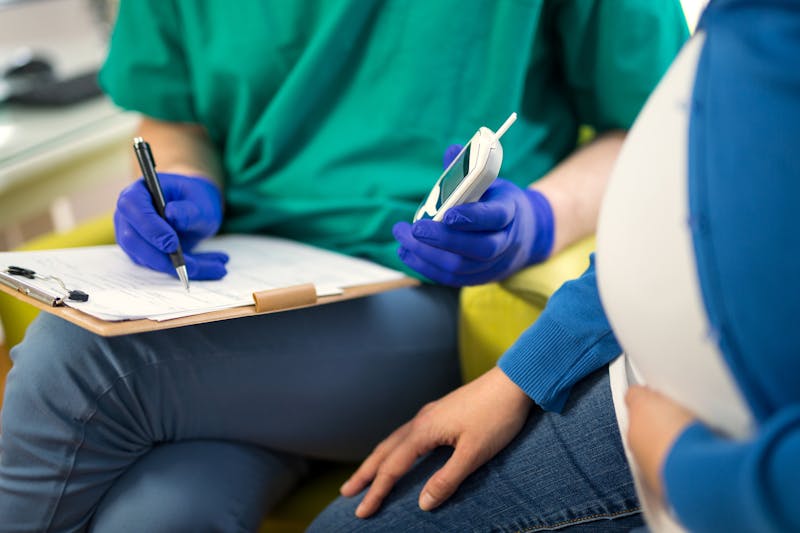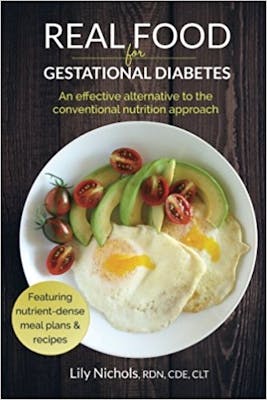Can low carb or keto help with gestational diabetes?

She ate what they advised — bananas, whole grain toast, fruit, rice, steel cut oats — and was checking her blood sugar with a home monitor seven times a day. The results were always too high. Soon she was on four insulin injections a day, but still the GD was uncontrolled. She developed preeclampsia (high blood pressure and protein in her urine). Her daughter was born by C-section at 37 weeks, weighing 8 lbs (4 kg). “The diet did not help me AT ALL!”
Finding the ketogenic diet
Six years later — after failed fertility treatments for her PCOS, a miscarriage, and a successful adoption — Natalie discovered ketogenic eating. She lost 40 lbs (18 kg) in three months, which brought her weight down to 210 lbs (95 kg), helping her infertility and her PCOS symptoms. Much to her surprise, after six years of infertility, she was suddenly pregnant.




In the second pregnancy she developed GD, again, at 18 weeks. Her doctors and dietitian gave her exactly the same advice — carbs at every meal and at three snacks a day for a minimum daily requirement of 175 grams. This time Natalie just smiled and nodded but kept her carbs below 50 grams and monitored her blood sugar regularly with a home meter. She eventually needed insulin, but just one injection at bedtime. “It wasn’t perfect, but I was much more successful at keeping my blood sugars in check. There was no way I could eat the amount of carbs they recommended. If I did, my blood sugars would be way too high.”
Now, age 36, she is happily pregnant for the third time at 24 weeks.
Will she still develop GD later in this pregnancy? She doesn’t know, but she will do her utmost not to up her carb consumption and will monitor her blood sugars regularly. She has set the goal of under 50 grams of carbs per day and hopes to get down to 25 grams if possible. “I cannot believe that 175 grams of carbs is still being recommended for GD! It is insane.”
Is the current advice based on solid science?




Nichols gives the same advice. She is the author of the 2015 book Real Food for Gestational Diabetes, offers an online gestational diabetes course and blogs at her web site.
Nichols has specialized in gestational diabetes for most of her career, initially with a California GD program called “Sweet Success,” which also recommended the minimum 175 grams of carbs daily. “It was always really disappointing to see how many of my prenatal clients would end up, as we say, ‘failing diet therapy’ and would have to go on insulin. It didn’t make sense to me why somebody with gestational diabetes, which translates as carbohydrate intolerance, would need such a high level of carbs,” said Nichols.
That experience set Nichols off digging into the historical literature to find out why 175 grams per day had become the minimum standard. “It turns out that this number is a best guess and not based in solid science. There is no evidence that eating fewer than 175 grams of carbohydrates is harmful.”




Reproductive expert Dr. Michael Fox notes that in obstetrics training, doctors are taught that ketones in the urine represent starvation ketosis. This is often seen in hyperemesis patients (severe nausea and vomiting) and in patients who are not eating enough calories during pregnancy.
Dr. Fox believes that as long as pregnant women are eating frequently (at least every 3 hours) and consuming plenty of calories (about 2500 calories or more per day), ketones in the urine or blood is not an abnormal state and should be expected with a ketogenic approach.
While pregnant women might get push-back from doctors not yet familiar with nutritional ketosis, one approach is to say, “I am following a ketogenic nutritional approach as I believe it is beneficial for my metabolic health, and this may result in ketones being detected in my urine. I would appreciate it if you could follow me during my pregnancy like you would anyone else, understanding that urine ketones are not necessarily a sign of trouble.”
While nutritional ketosis clearly appears to be safe in non-pregnant people, some doctors may continue to express concerns about a low-carb diet, given the lack of clarity in the medical literature regarding whether maternal ketones have any adverse effects on the developing baby.
Nonetheless, Drs. Fox and Jovanovic, as well as Ms. Nichols, all say that pregnant women with GD can reduce their carbohydrates and not fear ketones in their urine as long as their blood sugars remain normal and they are eating enough calories from nutrient dense foods.
In extensive interviews for this post, these experts offered four practical tips for managing the risk of GD for all pregnant women, especially those at higher risk of GD, such as women with polycystic ovarian syndrome (PCOS), prediabetes, obesity, and previous GD in pregnancy.
Tip #1: Have early blood sugar tests to assess your risk
Women who go into pregnancy with pre-existing insulin resistance, or undiagnosed pre-diabetes, are much more likely to develop GD.
An HbA1c test — which measures the average blood sugar levels in the previous three months — taken prior to pregnancy or early in the first trimester can help identify women at risk in advance. Values greater than 5.7% may indicate prediabetes, and many doctors treat this the same as gestational diabetes. The higher the number, the higher your average blood sugar. A level of 5.9% or higher accurately predicates gestational diabetes 98.4% of the time.
A fasting blood glucose prior to pregnancy or early in the first trimester can also help flag potential problems, if values are higher than 5.6 mmol/l (100 mg/dl), which is suggestive of prediabetes. Depending on your result, you may need to make blood sugar control a bigger priority. “Tackling it upfront can prevent blood sugar issues in the pregnancy and future complications,” Nichols said. Jovanovic agrees: “Waiting until 24 to 28 weeks to diagnosis GD means the fetus may have spent many weeks earlier in the pregnancy exposed to high blood sugars. You want to be on top of it early.”
Tip #2: Self monitor with a home glucose monitor
Women at higher risk of GD, with a confirmed GD diagnosis, or who are interested in knowing about how their pregnancy and their diet is impacting their blood sugar, should consider getting a home glucose monitor. Times of the day to test are: a fasting blood glucose first thing in the morning and one to two hours after every meal or snack. Or even better, ask your doctor for a prescription for a continuous glucose monitor (CGM).
Both note that if you have a couple of weeks showing normal blood sugar, you can keep eating the way you are eating. Just be aware that if your readings looked great in early pregnancy, you need to check again for a few weeks in the 24-28 week window since insulin resistance goes up later in pregnancy.
Many types of home glucose monitors are available from your local pharmacy. Follow the instructions that come with your particular meter. In general, wash your hands with soap and water and dry well before testing. Do not use alcohol wipes as this may alter the result. Also, do not touch any food before testing, as this can raise the readings.
The general consensus is that you are aiming for the following results:
- Fasting blood glucose less than 95 mg/dl (5.3 mmol/l).
- 1-hour post meal (postprandial) blood glucose less than 140 mg/dl (7.8 mmol/l)
- 2-hour post meal blood glucose less than 120 mg/dl (6.7 mmol/l)
Keep track of your daily blood glucose readings, the food you ate, and the exercise you did, either in a notebook or with an app or online tracker.
Tip #3: Understand the options for screening and diagnosis
Screening for GD typically happens in the first trimester for those at high risk (women with previous GD or PCOS) and at 24-28 weeks for all other pregnant women. The first test is typically the glucose challenge: drinking a standardized solution with 50 grams of sugar and having blood glucose tested one hour later.
It is well-known that people on low-carbohydrate diets are prone to false positive results when they have a glucose challenge. For this reason, women on low-carb diets who need to be screened for GD should consider raising their daily carbohydrate intake to above 150 grams a minimum of three days preceding a glucose challenge, although at least one study suggests it may take more than a week to fully adapt.
Many women find the sugary drink can cause nausea, vomiting, dizziness, and headache. Studies have found eating 50 grams of sugar in 28 jelly beans or 10 sticks of a very popular (in North America) strawberry-flavored licorice candy, called “Twizzlers,” may be easier to tolerate, with fewer side effects, but still provide the same results.




Women who fail the glucose challenge must then have a three-hour oral glucose tolerance test (OGTT) to confirm the GD diagnosis. That entails drinking twice the amount of sugar (100 grams) and having blood tested hourly over the following three hours.
The International Association of Diabetes and Pregnancy Study Group (IADPSG) recommends — and many countries other than the United States use — a single screening test: the 2-hour, 75-gram glucose tolerance test.
Nichols and Jovanovic believe that women can forgo the screening tests if they instead choose to track their blood sugar at home. “You can always decline the tests. You have that right. But you should be tracking your own sugars,” says Nichols. Jovanovic advises: “Just show [your doctors] your home blood sugars. That is all that matters.”
Tip #4: Eat a nutrient-dense “whole-food” diet
The cover of Nichols book features two fried eggs with sliced avocado and cherry tomatoes — a low-carb high-fat meal. “It is the perfect breakfast, or any meal, for gestational diabetes,” she says. Her advice: eat nutrient-dense foods over empty calories.
“Some low-carb people are just living off fat bombs and bulletproof coffee. You need to have good, common sense with variety in your diet.” She recommends having protein like meat, fish, and eggs; snacks like nuts and seeds; and lots of vegetables with natural fats like olive oil or butter. Nichols suggests eating liver once or twice a week, to help ensure a good natural intake of vitamins, minerals, and antioxidants in your diet.
She further recommends avoiding all highly processed foods, added sugar, refined carbs, as well as high-glycemic fruit and fruit juices. If your blood sugar is still high, consider cutting out all fruit except berries. “You do not need to add in bread and cereals to have a healthy pregnancy,” says Nichols. Pay attention to how you feel, and monitor your blood sugars. “Some pregnant women may feel better eating slightly more carbs, but I think the majority of women with GD, and all pregnant women in general, do better with at least one-half to one-quarter the carbohydrates recommended in conventional nutrition guidelines (which is upwards of 65% of calories from carbohydrates).”
Are gestational diabetes programs around the globe now registering that message and advising lower carb? Alas, not yet.
“What do you think would happen if I followed their advice?” asked Sarah incredulously, emailing the advice she received to Dr. Andreas Eenfeldt and the Diet Doctor team.
She believes that she’s likely been insulin resistant and prediabetic for years. She found the low-carb, high-fat diet and Diet Doctor five years ago. During this pregnancy, her third, she has been eating a more liberal low-carb diet, consuming more fruit than normal.
But now with the GD diagnosis, she is sticking to a lower-carb diet and monitoring her blood sugars regularly with a home meter, and she’s doing well. “Home monitoring is brilliant. I love doing it. I can see the impact of the foods I eat immediately,” says the math teacher. “I know if I followed the NHS dietary advice my blood sugar would get much, much worse.”
More
Is low carb safe during pregnancy?
Trying to conceive? Try the Better Baby Diet of beef, butter & bacon